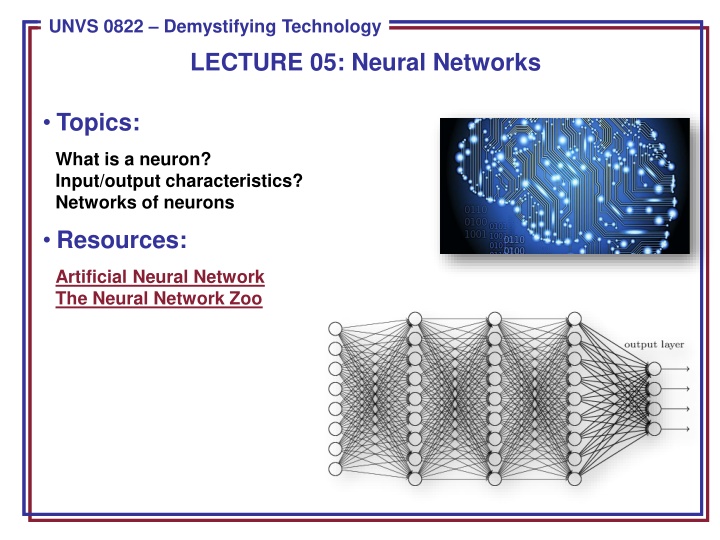
Neural Networks: Neurons, Perceptrons, and Sigmoid Neurons
Delve into the fundamentals of neural networks including neurons, perceptrons, and sigmoid neurons. Explore how these components function and interact in artificial intelligence systems for various applications.
Download Presentation

Please find below an Image/Link to download the presentation.
The content on the website is provided AS IS for your information and personal use only. It may not be sold, licensed, or shared on other websites without obtaining consent from the author. If you encounter any issues during the download, it is possible that the publisher has removed the file from their server.
You are allowed to download the files provided on this website for personal or commercial use, subject to the condition that they are used lawfully. All files are the property of their respective owners.
The content on the website is provided AS IS for your information and personal use only. It may not be sold, licensed, or shared on other websites without obtaining consent from the author.
E N D
Presentation Transcript
ECE 8443 Pattern Recognition UNVS 0822 Demystifying Technology LECTURE 05: Neural Networks Topics: What is a neuron? Input/output characteristics? Networks of neurons Resources: Artificial Neural Network The Neural Network Zoo
Neural Networks Artificial neural networks (ANNs) are algorithms modeled after how the human brain operates. ANNs today perform a number of functions including feature extraction, signal modeling and language or domain modeling. Neural networks are comprised of nodes, which combine the inputs from the data with a set of coefficients or weights and determine whether the signal will progress further through the network. UNVS 0822: Lecture 05, Slide 1
Nodes in Neural Networks The products between the inputs ?? and the weight ? are summed in the node and the result is passed to the node s activation function, which determines whether the node will fire. Perceptrons are the most fundamental and simplest models of neurons. Node Diagram UNVS 0822: Lecture 05, Slide 2
Perceptrons Perceptrons are very simple. They take several binary inputs and generate a single binary output. Given a set of inputs ??,??,??, and a set of corresponding weights ?, ?, ?, the neuron s output is given by: ? ?? ????? ????????? ?????? = ? ?? ?????> ????????? To simplify, ? and ? can be seen as vectors and the threshold is presented as a bias b, where ???? ????????? ?? ? ? ?????? = ? ?? ? ? + ? ? ? ?? ? ? + ? > ? ?? ?????? ? ?? UNVS 0822: Lecture 05, Slide 3
Sigmoid Neurons Learning algorithms involve the adjustment of the weights and bias If the neuron model used is the perceptron, a small change in a weight or bias can cause output to completely flip (being a binary model), and the flip can cause a change in the behavior of the entire network A new type of artificial neuron, a sigmoid neuron, is commonly used to overcome this issue ? In this case, the output is given by ? ? ?+??, where ? = ? ? + ? This means, the activation function is a logistic function. Other common activation function is the tanh function, given by ???? ? =?? ? ? ??+? ? UNVS 0822: Lecture 05, Slide 4
Networks of Nodes UNVS 0822: Lecture 05, Slide 5
Lab Exercise / Homework #2 Log into neuronix.nedcdata.org Save your old workspace: mv experiment experiment_old Create a new experiment: mkdir experiment cd experiment cp -r /data/isip/exp/theano/exp_0018/scripts . Run: python ./scripts/cpu_scripts/mnist_logistic.py Extract the results from the files and plot in Excel (as shown above): validation_report.txt test_report.txt Homework #2: Run: ./scripts/cpu_scripts/mnist_mlp.py Generate a comparison plot such as that shown above. UNVS 0822: Lecture 05, Slide 6
Summary A neural network attempts to emulate properties observed in the human brain: a simple computational element is used that emulates the basic properties of a neuron. By combining large numbers of these nodes in various topologies, we can solve complex engineering and scientific problems. Nodes can use a variety of activation functions ranging from simply hard limiters to soft mappings such as a sigmoid function. In this class we learned how to interpret the output and run a new network known as a multilayer perceptron. UNVS 0822: Lecture 05, Slide 7











